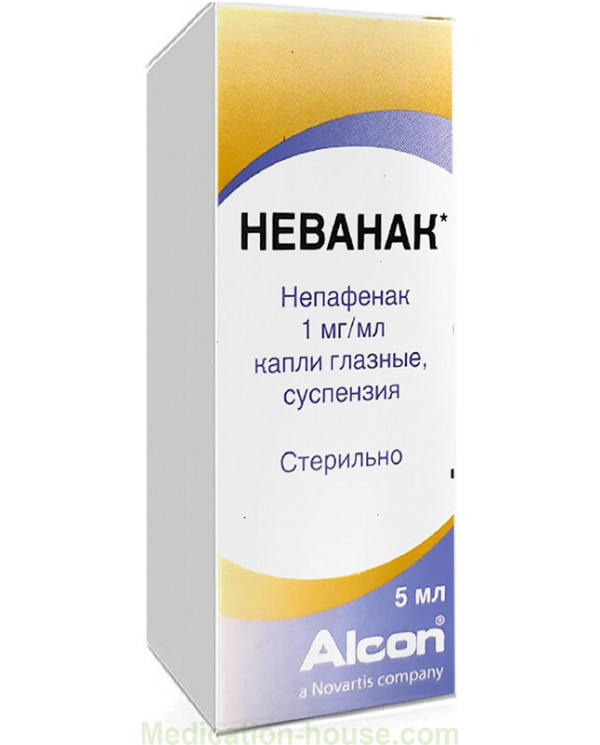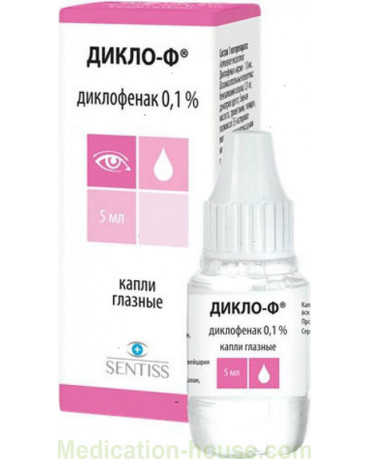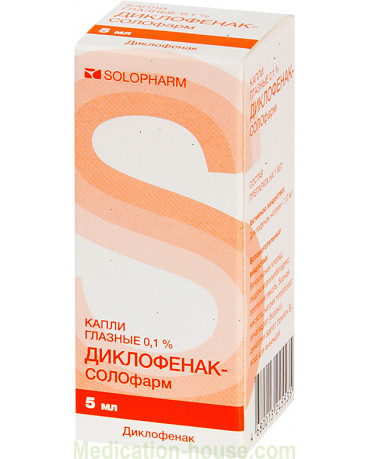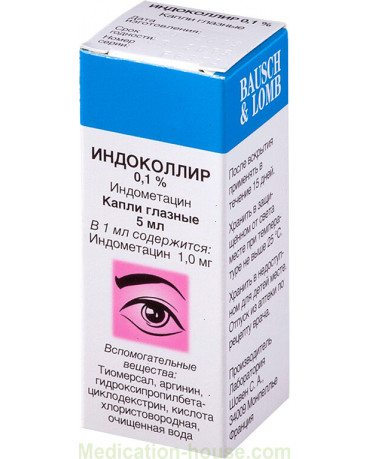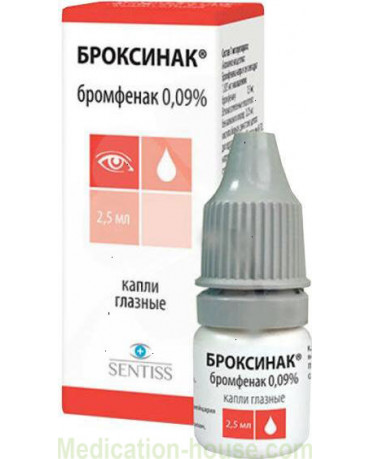Nevanac user manual
You can buy Nevanac here
Composition and form of release
The main active ingredient responsible for the therapeutic effect of the drug is nepafenac. Additional components that enhance its action and absorption in the eye chamber:
purified water;
tyloxapol;
mannitol;
hydrochloric acid and / or sodium hydroxide;
benzalkonium chloride;
carbomer;
disodium edetate.
The drops are a homogeneous suspension of light yellow or light orange color. The drug is packaged in dropper bottles with a volume of 5 ml. One cardboard box contains 1 bottle of drops, a dropper nozzle and an insert instruction.
Pharmachologic effect
Nevanac belongs to non-steroidal anti-inflammatory drugs (NSAIDs), which is used only locally (only for instillation in the eyes) for diseases of the organs of vision. It is a precursor to the active form of NSAIDs and has anti-inflammatory and analgesic effects. When used locally, getting into the cornea of the eye, nepafenac is converted into amphenac, which is already an active form that inhibits cyclooxygenase, which is necessary for the synthesis of prostaglandins.
After instillation, the drug is rapidly absorbed. The maximum level of Nevanac in the aqueous humor of the eye is noted after 1 hour. In the blood in the minimum concentration, the drug is detected after 2 hours in the form of nepafenac and after 3 hours in the form of amfenac. The active ingredient in the form of amfenac quickly binds to albumin, since it has a high degree of similarity with them. Most of the drug (about 85%) is excreted by the kidneys in the urine, a small portion through the gastrointestinal tract with feces.
Indications and contraindications for use
Restrictions on the use of drops in the eyes of Nevanac are:
pregnancy;
period of breastfeeding;
age under 18;
aspirin bronchial asthma and acute rhinitis developing against the background of other drugs related to NSAIDs.
intolerance to the constituent substances of the drug.
Eye drops Nevanac are used for prophylaxis, treatment of pain syndrome and inflammatory processes after surgery for cataract extraction. It is also prescribed to reduce the risk of macular edema in people with diabetes after lens surgery.
Instructions for use
Shake the bottle before use. It is desirable that the drops have room temperature, for this it is enough to hold the bottle in your palms, you cannot heat them on heating devices. To drip drops, you need to lie down and tilt your head back slightly, slightly push the lower eyelid with your index finger and drip the required number of drops into the conjunctival sac (under the lower eyelid).
During instillation, do not touch the tip of the vial with your fingers, as there is a possibility of infection in this way. Also, you can not touch the eyelids, eyelashes of the eye. For a better distribution of the drug over the surface of the eye, you need to blink quickly several times, or close your eyes and move your eyes in a circle, from left to right.
During the period of treatment, it is better to refuse wearing soft contact lenses, as the drops contain substances that discolor them. Ophthalmologists recommend not to use lenses at all until the course of treatment is over, but if refusal from them is not possible, then they are removed 5 minutes before the procedure and put on again after 15 - 20 minutes.
The drug is used 3 times a day, 1 drop. You need to use the drug one day before the operation, and also within two weeks after.
Additionally, drops are instilled 30-60 minutes before surgical treatment. The duration of treatment can be increased up to three weeks after surgery, if indicated.
Side effect, overdose
Side effects can be local and systemic. Local (related to the organ of vision):
iritis;
pain and discomfort in the eyes;
dry eye syndrome;
blepharitis;
allergic conjunctivitis;
increased lacrimation;
discharge from the eyes;
redness of the conjunctiva of the eye;
itchy eyes;
photophobia;
punctate keratitis;
blurred vision.
Systemic side effects:
increased blood pressure;
headache;
nausea, rarely vomiting;
feeling of dry mouth;
dizziness;
rhinitis, allergic nature.
If these symptoms occur, it is necessary to stop using the drug, especially if there are symptoms of damage to the cornea of the eye, such as corneal opacity and epithelial defect. The likelihood of these side effects increases if a person has diabetes mellitus, rheumatoid arthritis, a defect in the corneal epithelium, or drops are used during a second operation. There are no data on cases of overdose, when instilling excess drops, you must rinse your eyes with plain water.
Additional Information
It is necessary to use the drug strictly according to the dosage indicated in the instructions or by the doctor, not exceeding the duration of treatment, so as not to cause side effects
Special instructions for Nevanac
During the period of treatment, it is recommended to avoid exposure to sunlight. The use of non-steroidal anti-inflammatory drugs for local use can provoke the development of keratitis. In particularly susceptible people, their prolonged use can lead to damage (rupture) of the epithelial cells of the cornea, the formation of ulcers on it, and its thinning. These side effects are the risk of loss of vision.
The use of local NSAIDs can slow down the healing process, especially in combination with glucocorticosteroids.
The drug should be used with extreme caution in people who have diseases associated with impaired blood clotting properties, with a tendency to bleed. These conditions, in combination with the use of Nevanac, can provoke severe bleeding in the eye tissue. The same applies to people who, against the background of treatment with these drops, take drugs that increase blood clotting.
The medication contains benzalkonium chloride, which is a preservative. It can irritate the eyes and discolor soft contact lenses. Also, this component can cause toxic ulcerative keratitis or punctate keratitis, and therefore, with prolonged and frequent use of Nevanac, it is necessary to observe an ophthalmologist.
The use of drops can interfere with the timely diagnosis of an acute eye infection. In case of its appearance, the combination of NSAIDs and antibacterial drugs should be done with extreme caution. After instillation, a temporary decrease in vision clarity is possible, if this symptom occurs, then during the period of treatment it is not recommended to drive any vehicles, mechanisms and engage in work that requires a quick reaction and increased attention.
Interaction with other medicinal products
If Nevanac drops are used simultaneously with other ophthalmic agents, then the interval between their use should be at least 5 minutes. If eye ointments are prescribed, then they are laid last. There is no information on the use of the drug and prostaglandin analogues, but given their mechanism of action, their joint use is not recommended.
Conditions and shelf life
The product should be stored away from children, in a place protected from direct sunlight at temperatures from 5⁰ to 30⁰ C. Shelf life is 2 years from the date of manufacture, which is indicated on the carton. After opening the bottle, the drug retains its medicinal properties for 1 month. After the expiration date, it must be disposed of.
Reviews
Lyubov Vasilievna, 56 years old
Drops Nevanac, my doctor prescribed me when they performed the operation on the lens. The price is of course very expensive for me, but I had to buy it. The doctor said that they are necessary for my illness, and that they perfectly relieve pain after surgery and prevent inflammation. I dripped them before the operation and after it for another 2 weeks. The pain, of course, relieves quickly, after about 10 minutes it became easier and I had no complications.
Maria, 29 years old
My dad underwent surgery for glaucoma twice, first on one eye, and after 3 years on the other. And each time he was prescribed Nevanac. The list of side effects, of course, scared, but once prescribed, I had to apply. And in vain they were afraid, the pope did not have any side effects.
Terms of sell
You don't need a prescription from a doctor to buy Nevanac.

